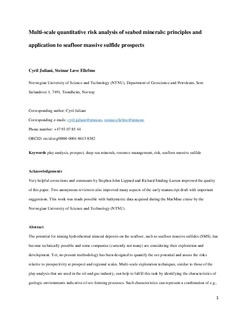| dc.contributor.author | Juliani, Cyril Jerome | |
| dc.contributor.author | Ellefmo, Steinar Løve | |
| dc.date.accessioned | 2019-05-07T10:13:17Z | |
| dc.date.available | 2019-05-07T10:13:17Z | |
| dc.date.created | 2018-11-23T11:57:14Z | |
| dc.date.issued | 2018 | |
| dc.identifier.citation | Natural Resources Research. 2018, 1-22. | nb_NO |
| dc.identifier.issn | 1520-7439 | |
| dc.identifier.uri | http://hdl.handle.net/11250/2596756 | |
| dc.description.abstract | The potential for mining hydrothermal mineral deposits on the seafloor, such as seafloor massive sulfides, has become technically possible, and some companies (currently not many) are considering their exploration and development. Yet, no present methodology has been designed to quantify the ore potential and assess the risks relative to prospectivity at prospect and regional scales. Multi-scale exploration techniques, similar to those of the play analysis that are used in the oil and gas industry, can help to fulfill this task by identifying the characteristics of geologic environments indicative of ore-forming processes. Such characteristics can represent a combination of, e.g., heat source, pathway, trap and reservoir that all dictate how and where ore components are mobilized from source to deposition. In this study, the understanding of these key elements is developed as a mineral system, which serves as a guide for mapping the risk of the presence or absence of ore-forming processes within the region of interest (the permissive tract). The risk analysis is carried out using geoscience data, and it is paired with quantitative resource estimation analysis to estimate the in-place mineral potential. Resource estimates are simulated stochastically with the help of available data (bathymetric features in this study), conventional grade–tonnage models and Monte Carlo simulation techniques. In this paper, the workflow for a multi-scale quantitative risk analysis, from the definition to the evaluation of a permissive tract and related prospect(s), is described with the help of multi-beam data of a known hydrothermal vent site. | nb_NO |
| dc.language.iso | eng | nb_NO |
| dc.publisher | Springer Verlag | nb_NO |
| dc.title | Multi-scale Quantitative Risk Analysis of Seabed Minerals: Principles and Application to Seafloor Massive Sulfide Prospects | nb_NO |
| dc.type | Journal article | nb_NO |
| dc.type | Peer reviewed | nb_NO |
| dc.description.version | acceptedVersion | nb_NO |
| dc.source.pagenumber | 1-22 | nb_NO |
| dc.source.journal | Natural Resources Research | nb_NO |
| dc.identifier.doi | 10.1007/s11053-018-9427-y | |
| dc.identifier.cristin | 1634223 | |
| dc.relation.project | Norges forskningsråd: 247626 | nb_NO |
| dc.description.localcode | This is a post-peer-review, pre-copyedit version of an article published in [Natural Resources Research] Locked until 8.11.2019 due to copyright restrictions. The final authenticated version is available online at: https://doi.org/10.1007/s11053-018-9427-y | nb_NO |
| cristin.unitcode | 194,64,90,0 | |
| cristin.unitname | Institutt for geovitenskap og petroleum | |
| cristin.ispublished | true | |
| cristin.fulltext | original | |
| cristin.qualitycode | 1 | |
